
Carson City, officially the Consolidated Municipality of Carson City, is an independent city and the capital of the U.S. state of Nevada, named after the mountain man Kit Carson. As of the 2010 census, the population was 55,274, making it the sixth largest city in Nevada. The majority of the town's population lives in Eagle Valley, on the eastern edge of the Carson Range, a branch of the Sierra Nevada, about 30 miles (50 km) south of Reno.

Douglas County is a county in the northwestern part of the U.S. state of Nevada. As of the 2010 census, the population was 46,997. Its county seat is Minden. Douglas County comprises the Gardnerville Ranchos, NV Micropolitan Statistical Area, which is also included in the Sacramento–Arden-Arcade–Yuba City, CA–NV Combined Statistical Area.

Minden is a census-designated place (CDP) in Douglas County, Nevada, United States. The population was 3,001 at the 2010 census. It is the county seat of Douglas County and is adjacent to the town of Gardnerville. It was founded in 1906 by Heinrich Friedrich Dangberg Jr., who named it after the town of Minden, in the German state of North Rhine-Westphalia, which was near his father's birthplace. A large share of the first settlers were Germans. Minden was founded on company land of the Dangberg Home Ranch and Dangberg commissioned most of the town's early buildings. Minden has had a post office since 1906.
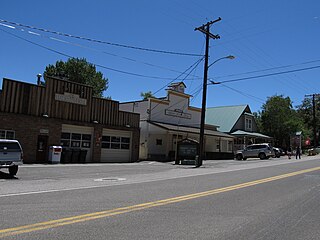
Genoa is an unincorporated town in Douglas County, Nevada, United States. Founded in 1851, it was the first settlement in what became the Nevada Territory. It is situated within Carson River Valley and is approximately 42 miles (68 km) south of Reno at 39.005,-119.846. The population was 939 at the 2010 census. It is home to the oldest bar in the state of Nevada which opened in 1853.
Frederic Joseph DeLongchamps was an American architect. He was one of Nevada's most prolific architects, yet is notable for entering the architectural profession with no extensive formal training. He has also been known as Frederick J. DeLongchamps, and was described by the latter name in an extensive review of the historic importance of his works which led to many of them being listed on the U.S. National Register of Historic Places in the 1980s.

The Nevada State Capitol is the capitol building of the U.S. state of Nevada located in the state capital of Carson City at 101 North Carson Street. The building was constructed in the Neoclassical Italianate style between 1869 and 1871. It is listed in the National Register of Historic Places. It is also Nevada Historical Marker number 25.

Fort Churchill State Historic Park is a state park of Nevada, United States, preserving the remains of a United States Army fort and a waystation on the Pony Express and Central Overland Routes dating back to the 1860s. The site is one end of the historic Fort Churchill and Sand Springs Toll Road. The park is in Lyon County south of the town of Silver Springs, on U.S. Route 95 Alternate, eight miles (13 km) south of U.S. Route 50. Fort Churchill was designated a National Historic Landmark in 1961. A 1994 park addition forms a corridor along the Carson River.
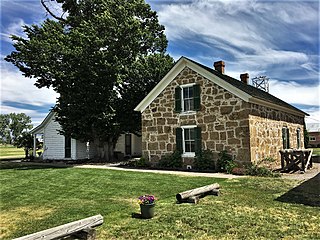
The Dangberg Home Ranch Historic Park is a Douglas County, Nevada, USA, park, preserving one of the state's first ranches.
The Virginia & Truckee (V&T) Railroad Depot of Carson City, Nevada is a historic railroad station that is listed on the U.S. National Register of Historic Places (NRHP). It is significant for its association with the economically important role of the V&T railroad historically in Carson City following discovery of the Comstock Lode mine in 1859. To a lesser degree, according to its NRHP nomination, the depot building is also significant architecturally "as a well-preserved example of a wood-frame passenger depot procured from a railroad company pattern book within the V&T's former sphere of operation."

Farmer's Bank of Carson Valley is a historic bank building located at 1597 Esmeralda Avenue in Minden, Nevada. The bank was built from 1916 to 1918 to replace the original 1909 bank building, which the Farmer's Bank had outgrown. Prominent Nevada architect Frederic Joseph DeLongchamps designed the building in the Classical Revival style; the bank is one of many Neoclassical structures designed by DeLongchamps in Minden. The bank's design features a cornice with terra cotta tiles and bands, a flat roof with a low parapet, and an entrance portico with Ionic columns. The bank was built for Farmer's Bank organizer H. F. Dangberg, who was also the founder of Minden. The building served as a bank until 1968 and currently houses offices.

The Carson Valley Improvement Club Hall is a historic building located at 1606 Esmeralda Avenue in Minden, Nevada. The building was constructed in 1912 as a meeting hall for the Carson Valley Improvement Club. The two-story building features a variety of brickwork patterns but has an otherwise plain design. The Carson Valley Improvement Club used the building to host both community social events and town meetings. The building has served as the informal seat of government in Minden since its construction; after the Carson Valley Improvement Club moved out in 1920, the Minden Commercial Club and later the Minden Town Board continued to hold government meetings at the building. Though Minden is unincorporated, the groups meeting in this building have acted as local liaisons to Douglas County's government and have helped manage local government services. In addition, the building has continued to house a variety of social events, including concerts, movies, religious services, and basketball games.
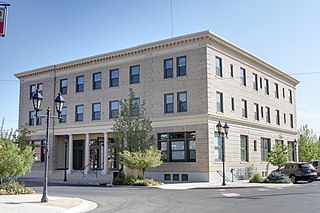
The Minden Inn is a historic hotel building located at 1594 Esmeralda Avenue in Minden, Nevada. Built from 1912 to 1916, the building was designed by prominent Nevada architect Frederic Joseph DeLongchamps in the Classical Revival style. The hotel was the largest commercial building in Minden and was operated by H. F. Dangberg, the founder of the town. The inn earned a reputation as "one of the finest small hotels on the West Coast" and was visited by a number of actors and celebrities who passed through Minden on the Virginia and Truckee Railroad. In addition, the hotel included a bar and gambling operations until 1987. The building now houses Douglas County offices.

The Minden Flour Milling Company is a historic flour mill located at 1609 U.S. Highway 395 in Minden, Nevada. Built in 1906, the mill was the largest of five flour mills built in the Carson Valley and is the only one still in existence. The building has a transitional design in two respects, as it reflects the change from early European-influenced mills to 20th-century American mills as well as the move from smaller rural mills to large mills built along railroads. The mill features a masonry bearing-wall style of construction, a concrete foundation considered novel at the time, and well-crafted masonry and woodwork. The operators of the mill had a significant influence on Minden commerce, as they were instrumental in both the extension of the Virginia and Truckee Railroad to the town and the expansion of electric power to the area. By the 1920s, the mill had become "one of the biggest milling concerns in the state"; it could process 100 barrels of flour a day and also produced chicken and cattle feed. The mill operated until the 1960s.

The Minden Wool Warehouse is a historic warehouse building located at 1615 Railroad Avenue in Minden, Nevada. Built in 1915, the warehouse was designed by prominent Nevada architect Frederic Joseph DeLongchamps. DeLongchamps designed the building for H. F. Dangberg, the founder of Minden, and the warehouse served as the headquarters for Dangberg's Dangberg Land and Livestock Company. Carson Valley farmers used the warehouse to store wool and potatoes before they were shipped out of Minden. The warehouse was later rented to the Minden Flour Company and a local creamery; it is now used as an office building by the Bently Nevada Corporation.
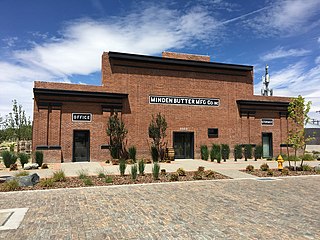
The Minden Butter Manufacturing Company, also known as the Minden Creamery, is a historic creamery building located at 1617 Water St. in Minden, Nevada. Built in 1916, the creamery was designed by noted Nevada architect Frederic Joseph DeLongchamps. The creamery replaced the Minden Butter Manufacturing Company's first building, which was built in 1908, so the company would have space to pasteurize its products. The company sold butter and other produce under the Windmill brand name and eventually became the largest creamery in Nevada. While the company mainly shipped its goods to the San Francisco area, it also sold internationally; the year before the creamery was built, it sent a large shipment of butter to China. The creamery building is now used by Bently Nevada for manufacturing purposes.
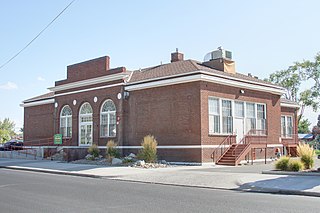
Minden Elementary School, also known as Minden Grammar School, is a historic school building located at 1638 Mono Avenue in Minden, Nevada. The Renaissance Revival school was built in 1918 at a cost of $14,291. The school replaced the county's first school, a 1908 building known as the "little green schoolhouse". The school operated until it closed in 1980 and now serves as an office building for the Douglas County School District.

The Carson Valley Hospital is a historic hospital located at 1466 U.S. Route 395 in Gardnerville, Nevada. The hospital was built in 1914 by Dr. E. H. Hawkins, the county physician and health officer of Douglas County. The hospital was regarded as one of Nevada's best, and it included modern tools such as an X-ray machine, a rarity in small town hospitals at the time. While Hawkins anticipated that Douglas County would need a modern hospital for its growing population, the county's population actually fell at the 1920 census, and the community struggled to keep its hospital open. Hawkins sold the hospital in 1918, and it closed in 1924. The building was used for housing until 1958, when it was vacated.

The Arendt Jensen House, at 1431 Ezell St. in Gardnerville, Nevada, is a historic foursquare house—in this case termed a "Denver Square" form—that was built in 1910. It was a home of Danish immigrant Arendt Jensen, a merchant who became prominent in Gardnersville. Also known as the Reid Mansion, it includes Colonial Revival-style ornamentation. It was listed on the National Register of Historic Places in 1989; the listing included two contributing buildings: the second is an accompanying garage.

The Cattle Bank is a historic bank building located at 102 E. University Ave. in Champaign, Illinois. Built in 1858, it is the oldest documented commercial structure in Champaign. It opened as a branch of the Grand Prairie Bank of Urbana, Illinois. Champaign was the southern terminus of a railroad line to Chicago, so cattle raisers from the surrounding area drove their cattle to Champaign to ship them to the Chicago market. The Cattle Bank provided banking and loan services to these cattlemen. The building housed a bank for only three years. During that time, U.S. President Abraham Lincoln is known to have cashed a check there. From 1861 to 1971, the building housed several commercial tenants. It was added to the National Register of Historic Places in 1975 and renovated in 1983. Since 2001, the Cattle Bank has been home to the Champaign County History Museum.

Siebels' Department Store-Boyer Valley Bank, also known as I.0.0.F. Hall, Nicely Building, Whitmore's, and the Rena Barry Building, is a historic building located in Woodbine, Iowa, United States. Siebels' was one of the largest, longest-lasting and most well-known stores in Woodbine. Adolph Siebels moved here from Minden, Iowa in 1904 and bought a grocery store. He expanded the store's offerings to include clothing, housewares and other items. Siebels expanded the store in 1907 and again in 1908. He sold shares in the store to some of his employees in the 1920s, and the store remained in business under three owners until 1954.




















